介词总结表格
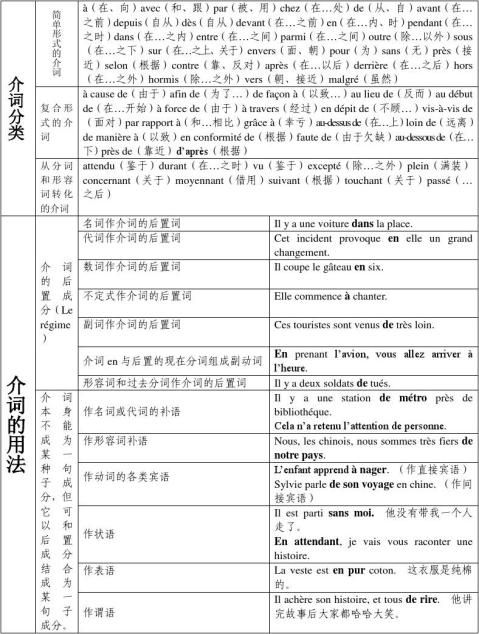
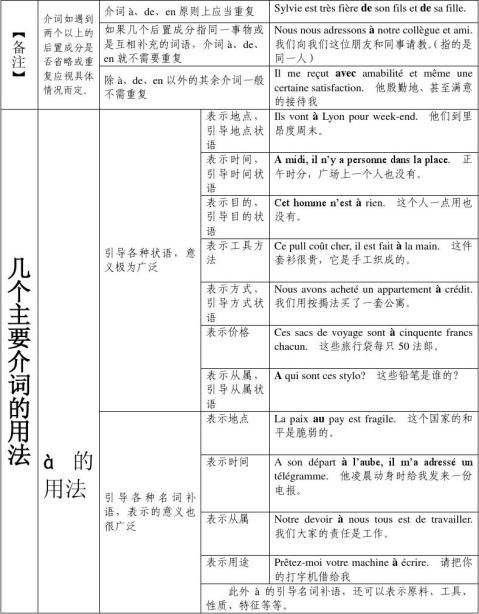
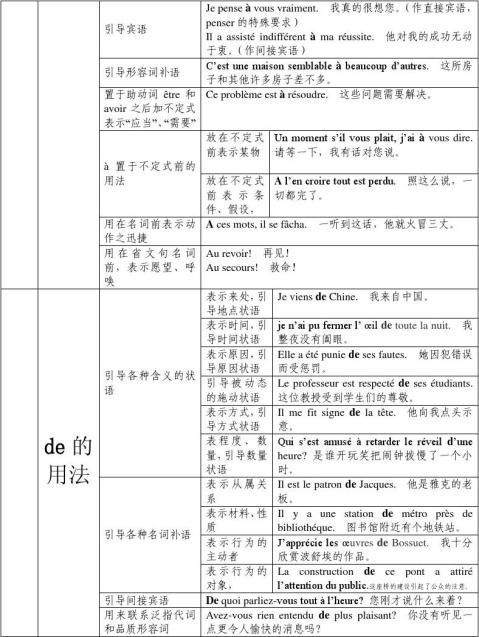
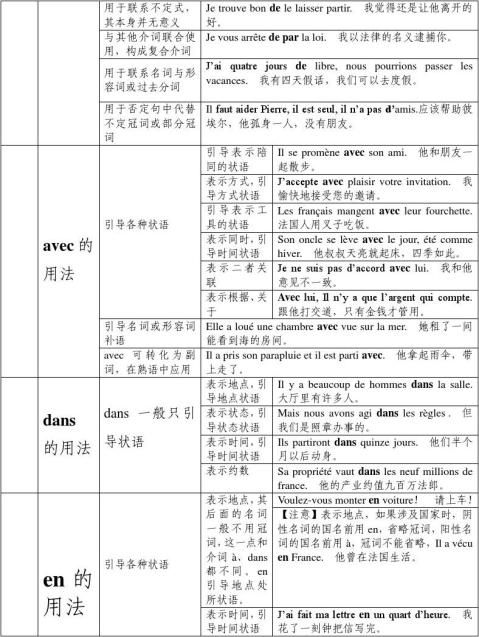
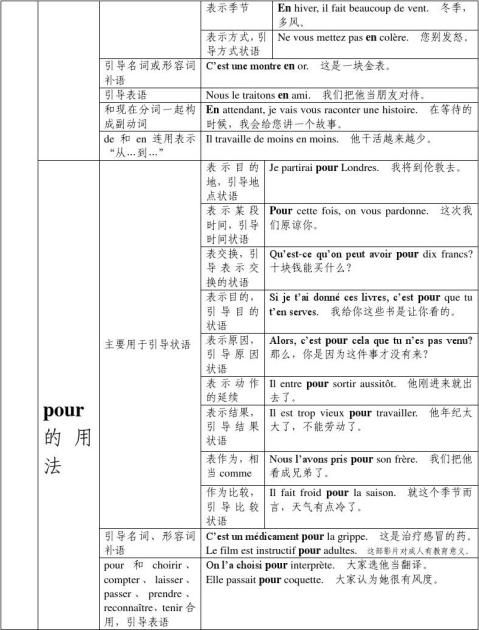
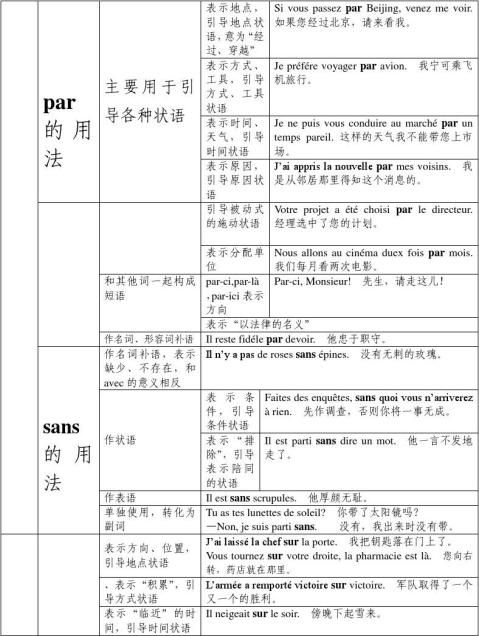

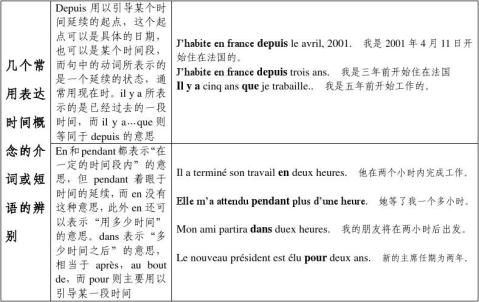
第二篇:介词用法总结 分享
介词和冠词
一、概念:
介词是一种用来表示词与词, 词与句之间的关系的词。在句中不能单独作句子成分。介词后面一般有名词代词或相当于名词的其他词类,短语或从句作它的宾语。介词和它的宾语构成介词词组,在句中作状语,表语,补语或介词宾语。并且在定语从句“介词+whom/which”的结构中,不能用that 代替whom/which。She is a good student from whom we should learn
1.表示地点位置的介词
1)at ,in, on, to,for
at (1)表示在小地方; (2)表示“在……附近,旁边”
in (1)表示 在大地方; (2)表示“在…范围之内”。
on 表示毗邻,接壤,“在……上面”。
to 表示在……范围外,不强调是否接壤;或“到……”
2)above, over, on 在……上
above 指在……上方,不强调是否垂直,与 below相对;
over指垂直的上方,与under相对,但over与物体有一定的空间,不直接接触。
on表示某物体上面并与之接触。
The bird is flying above my head.
There is a bridge over the river.
He put his watch on the desk.
3)below, under 在……下面
under表示在…正下方
below表示在……下,不一定在正下方
There is a cat under the table.
Please write your name below the line.
4)in front [frant]of, in the front of在……前面
in front of…意思是“在……前面”,指甲物在乙物之前,两者互不包括;其反义词是behind(在……的后面)。
There are some flowers in front of the house.(房子前面有些花卉。) in the front of 意思是“在…..的前部”,即甲物在乙物的内部.反义词是at the back of…(在……范围内的后部)。
There is a blackboard in the front of our classroom.
我们的教室前边有一块黑板。
Our teacher stands in the front of the classroom.
我们的老师站在教室前.(老师在教室里)
5)beside,behind
beside 表示在……旁边
behind 表示在……后面
2.表示时间的介词
1)in , on,at 在……时
in表示较长时间,如世纪、朝代、时代、年、季节、月及一般(非特指)的早、中、晚等。
如 in the 20th century, in the 1950s, in 1989, in summer, in January, in the morning, in one’s life , in one’s thirties等。
on表示具体某一天及其早、中、晚。
如on May 1st, on Monday, on New Year’s Day, on a cold night in January, on a fine morning, on Sunday afternoon等。
at表示某一时刻或较短暂的时间,或泛指圣诞节,复活节等。 如at 3:20, at this time of year, at the beginning of, at the end of …, at the age of …, at Christmas, at night, at noon, at this moment等。 注意:在last, next, this, that, some, every 等词之前一律不用介词。如:We meet every day.
2)in, after 在……之后
“in +段时间”表示将来的一段时间以后;
“after+段时间”表示过去的一段时间以后;
“after+将来点时间”表示将来的某一时刻以后。
3)from, since 自从……
from仅说明什么时候开始,不说明某动作或情况持续多久; since表示某动作或情况持续至说话时刻,通常与完成时连用。
4)after, behind 在……之后
after主要用于表示时间;
behind主要用于表示位置。
时间名词前介词用法口诀
年前周前要用in
具体日子却要禁
遇到几号要用on
上午下午又是in
要说某日上下午
用on换in记清楚
午夜黄昏用at
黎明用它也不错
at用在时分前
说“差”可要用上to
说"过''要用past
3.表运动方向的介词:
across, through 通过,穿过
across表示横过,即从物体表面通过,与on有关;
through穿过,即从物体内部穿过,与in有关。
4.表示“在……之间”的介词:
between, among
between指在两个人或两个事物之间;
among指在三个或三个以上的人或事物之间。
5.表示其他意义的介词
1)on ,about 关于
on 表示这本书,这篇文章或演说是严肃的,或学术性的,可供专门研究这一问题的人阅读;
about表示内容较为普通,不那么正式。
2)by, with, in 表示方法、手段、工具
by 以……方法、手段或泛指某种交通工具;
with 表示用 …工具、手段,一般接具体的工具和手段; in 表示用…方式,用…语言(语调、笔墨、颜色)等;
3)except, besides 除了
except 除……之外,不包括在内;
besides 除……之外,包括在内。
Except Mr. Wang, we went to see the film.(王先生没去)
Besides Mr. Wang, we also wentting to see the film.(王先生也去了)
-
介词的详细总结好
知识网络时间介词介词的分类地点介词方式介词定语状语介词介词的功能表语宾语介词名词介词短语动词介词be形容词介词介词是一种虚词不能单…
- 介词总结表格
-
介词的用法总结
介词的用法1表示地点位置的介词1atinontoforat1表示在小地方2表示在附近旁边in1表示在大地方2表示在范围之内on表示…
-
介词经典总结
介词综合知识点在近旁从物体中间穿透穿越在右边从物体上面跃过在左边从树上摔下来在外部前面直走在什么内部前面右拐穿过森林公园窗户go左…
-
常用介词短语总结
介词与其他词类的固定搭配介词常常和形容词名词动词等构成固定搭配以表示固定的意义1形容词与介词的固定搭配形容词与介词的固定搭配1形容…
-
小学英语介词总结
介词(Preposition)一、概述介词是英语中很活跃的词,一般置于名词之前。它常和名词或名词性词语构成介词短语。同一个介词常和…
-
介词的用法经典总结
介词属虚词,不能单独使用,必须和名词、代词或动名词构成介词短语,在句中做表语、定语、状语、补语等成分:至少分为5类时间:强调动作的…
-
公共法语常用介词用法总结
法语介词用法à1.引导地点状语:Mongrand-pèrevaàParisavecnous.我的祖父和我们一起去巴黎。(aller…
-
初中英语介词总结
介词考点1、表示时间的介词表示时间的介词有at,in,after,until,before,during.1.at多用于表示具体的…
-
初中介词用法总结
介词英文缩写是prep.是英文preposition的缩写1.表示地点位置的介词1)at,in,on,to,forat(1)表示在…